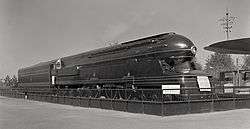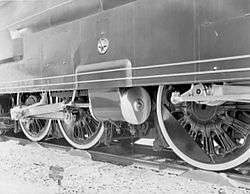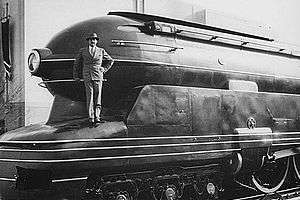PRR S1
|
Industrial designer Raymond Loewy stands on the front of the S1 | |||||||||||||||||||||||||||||||||||||
| |||||||||||||||||||||||||||||||||||||
| |||||||||||||||||||||||||||||||||||||
| |||||||||||||||||||||||||||||||||||||
| |||||||||||||||||||||||||||||||||||||
The PRR S1 class steam locomotive (nicknamed "The Big Engine") was a single experimental locomotive, the longest and heaviest rigid frame reciprocating steam locomotive ever built.[1] The streamlined Art Deco styled shell of the locomotive was designed by Raymond Loewy.[1][2]
The S1 was the only locomotive ever built with a 6-4-4-6 wheel arrangement. It was a duplex locomotive, meaning that it had two pairs of cylinders, each driving two pairs of driving wheels. Unlike similar-looking articulated locomotive designs, the driven wheelbase of the S1 was rigid. The S1 was completed January 31, 1939 and was numbered 6100.
At 140 ft 2 1⁄2 in (42.74 m) overall, engine and tender, the S1 was the longest reciprocating steam locomotive ever; it was too big for many PRR curves. Along with wheel slippage, this limited the S1's usefulness. No further S1 models were built as focus shifted to the T1 class.
Construction history
In 1937 Pennsylvania Railroad officials decided to build a new passenger locomotive to replace its aging K4s locomotive. The PRR officials also hoped that the new S1 steam locomotive would have performance equal to their GG1 electric locomotive.[3]
In a collaborative effort, the Pennsylvania Railroad, Baldwin Locomotive Works, the Lima Locomotive Works and the American Locomotive Company contributed to the experimental S1 design.[3]
The S1 was the largest passenger locomotive ever constructed, with an overall length of 140 feet 2 1⁄2 inches (42.74 m). At 77 feet (23.47 m) long and a weight of 97,600 pounds (44,300 kg; 44.3 t), the cast steel locomotive bed plate made by General Steel Castings was the largest single-piece casting ever made for a locomotive.[3][4]
The boiler for the S1 was the largest built by the Pennsylvania Railroad, with 660 square feet (61 m2) of direct heating surface and 500 1 inch tubes and flues. The six-wheel leading and trailing trucks were added, as the locomotive was too heavy for four-wheel units. The streamlined Art Deco styled shell of the locomotive was designed by Raymond Loewy,[1][2] for which he received U.S. Patent No. 2,128,490. The cost of an S1 was $669,780.00, equal to $11,413,500 today.[3]
To get enough steel between the crank and axle, the back end of each main rod was offset 1 1⁄8 inches (29 mm) from the crank in the driver, so the big end made a 26-inch (660 mm) circle while each siderod pin made a 28 1⁄4-inch (718 mm) circle.
World's fair display

The S1 was displayed at the New York World's Fair of 1939 with the lettering "American Railroads" rather than "Pennsylvania Railroad", as 27 eastern railroads had one combined 17-acre (6.9 ha) exhibit, which also included the Baltimore & Ohio's duplex locomotive.[4] To reach the Fair the S1 took a circuitous route over the Long Island Rail Road. Many obstacles had to be temporarily removed and other obstacles were passed at a crawl to reach the fairgrounds. At the Fair the drive wheels operated under the locomotive's own steam power.[3] This was done by placing the S1 on a platform that had rollers under the drive wheels. After the World's Fair the S1 was relettered and numbered for the Pennsylvania Railroad fleet. The S1 was used by the PRR for publicity purposes as well and its image was featured in calendars and brochures.
Service history

The S1 class locomotive was so large that it could not negotiate the track clearances on most of the lines of the PRR system. In its brief service life it was restricted to the main line between Chicago, Illinois and Crestline, Ohio. It was assigned to the Fort Wayne Division and based at the Crestline enginehouse. The S1 hauled passenger trains such as The General and The Trailblazer on this route.[3] Crews liked the S1, partly because of its very smooth ride. The great mass and inertia of the locomotive soaked up the bumps and the surging often experienced with duplex locomotives.
Starting tractive effort calculated in the usual way (85% mean effective pressure) comes out 76,400 lbf (340 kN), but the engine used 70% limited cutoff (presumably to increase port openings at short cutoff) so the railroad claimed a correspondingly lower tractive effort.
Design flaws
The lack of curve compatibility led to the S1 not being used for its intended long distance express service.
The S1 had less than half its total weight on the driving wheels, the rest being carried by the massive six-wheel pilot (leading) and trailing truck. This left the two sets of four duplex driving wheels susceptible to wheel slippage, a dangerous condition for any steam locomotive.
When the powered wheels of a steam locomotive lose their adhesion to the rails and freely spin, the result is over speed damage. If the locomotive's engineer does not detect and rectify this situation at once two things will occur: first, the metal tires that surround the driving wheels will be seriously damaged; second, the piston rods, their bearings and the other equipment associated with the reciprocating motion of the engine will be overstressed and destroyed; the engine will literally tear itself apart, by its operation at speeds well beyond the design limitations.
Normally, in a standard locomotive when starting under load from standing start, the engineer would observe his rearmost driving wheels and compare their movement to the movement of his locomotive over the ground. As locomotives grew larger, the engineer would listen to the rhythmic sound of the exhaust (the characteristic “chug-chug”) and compare the rhythm of this sound with the movement of his locomotive over the ground.
If, as he opened his engine’s throttle, the rate of increase of the “chug chug” sound was out of sync with the forward progress of his locomotive, he knew his wheels were slipping. A passenger locomotive with 72-inch-diameter (1,829 mm) drivers would travel nineteen feet (5.79 m) (over six yards or 5.49 meters) per “chug-chug”. It was therefore easy to correlate the rhythmic sound of the exhaust of a starting locomotive with the locomotive’s progress from a standing start. An engineer could thereby avoid applying too much power to a starting locomotive (by opening the steam throttle valve too much, and too quickly) and causing the wheels to slip.

The S1’s duplex engine design meant that two separate engines were concurrently and in sequence exhausting into the single smoke stack. This made it nearly impossible for a locomotive engineer to distinguish the behavior of an individual engine set, based upon the sound of its exhaust. Unless both sets of engines experienced wheel slip simultaneously, the sound of the normal set would mask the sound of the set that was slipping and over speeding. If the wheels began to slip he would have no knowledge of this fact until he had already damaged the tires of the duplex engine’s wheels; or he heard the crashing sounds of a duplex engine tearing itself apart, in over speed.
The S1 had a further handicap in the area of slippage. Unlike virtually all other steam locomotives that faced wheel slippage when starting, the S1 (because of the very light weight on the driving wheels) would experience engine wheel slip over the road at operating speed. The adhesion of the wheels to the rails was so light that even minor variations in the roadbed would cause either the forward or rearward duplex engines to slip. This hazard more than any other doomed the operating life of this engine. The loss of adhesion at speed (30–50 mph or 48–80 km/h & +) always did serious mechanical damage to the engine which lost adhesion, and to the locomotive as well.
The design flaws of the S1 related to curve compatibility and wheel slip led to only one example being produced. A revised, shorter design that used four wheel lead and trailing trucks to place more weight on the drivers was developed for Baldwin's next iteration, the 4-4-4-4 T1. Unlike the S1, the T1 was actually used for long distance express service with such trains as the Broadway Limited and the Manhattan Limited, but the T1 was also plagued by wheel slip and related mechanical failures.
Alleged speed records
An article "Riding the Gargantua of the Rails" in the Dec 1941 Popular Mechanics Magazine cites a speed of 133.4 miles per hour (214.7 km/h). There are other stories of the S1 reaching or exceeding 140 miles per hour (230 km/h). In the German trade press and literature from 1945 there was a report of a record run of the S1, citing railroad officials that a speed of 141 mph (227 km/h) had been reached.
Its high speed capability was such that many have claimed that the S1 exceeded on multiple occasions the 126 mph (203 km/h) record steam locomotive speed set in 1938 by the LNER locomotive Mallard. The locomotive was claimed to have exceeded 156 mph (251 km/h) on the Fort Wayne-Chicago run, as it was reported that the PRR received a fine for the feat.
Removal from service
According to a time-book belonging to Pennsy engineman Byron Breininger from the Ft. Wayne division records a trip to Chicago on S-1 engine 6100 at 8:59 AM on May 5, 1946, this run was possibly one of its last in service. The engine was scrapped in 1949.[3][5] The PRR continued developing the T1 class of 4-4-4-4 duplex locomotives but this locomotive model also met with limited success.
Modern culture
The design of the S1 has proved to be very popular:
- The S1 was represented in a 1939 painting by railroad artist Grif Teller that appeared in the Pennsylvania Railroad's picture calendar.
- In the PC game Gadget: Invention, Travel, & Adventure, one of the trains the player travels on is pulled by an S1 modeled locomotive.
- The Danish pop group 'Laid Back's third album 'Play It Straight', released in 1985, features a three-quarter view of the S1's bow on its cover, albeit in a gaudy pinkish red hue it never wore in service.

- The S1 appears in the Sandman comic series, book IX.
- In the anime The Galaxy Railways, the engine for Vega Platoon, Iron Burger, is loosely based on the S1, with the 4-8-8-4 wheel arrangement used for the Union Pacific Big Boy, which was used as the bases for Big One, the engine for Sirius Platoon.
- The S1 appears in the PC game Grim Fandango as "number nine"—the best vehicle for travel to the eternal rest.
- The S1 also appears in GeoTrax as the Higland Senic Lines in 2004 and Brutis and Victor in 2007.
See also
References
- 1 2 3 "Raymond Loewy-Locomotives". The Avanti. Archived from the original on 2007-09-27. Retrieved 2007-09-02.
- 1 2 "It's a bird! It's a plane! No, it's - an office tool". The Home Forum > Essays. The Christian Science Monitor. September 23, 2004. Retrieved 2007-09-04.
- 1 2 3 4 5 6 7 "Actual Production Models Shown". Brochures. www.lionel.com. 2003. Retrieved 2007-09-03.
- 1 2 Reed, Brian (June 1972). Pennsylvania Duplexii. Loco Profile 24. Windsor, Berkshire: Profile Publications Limited. pp. 267–271.
- ↑ "PRR Chronology 1945" (PDF). PRR Chronology. Pennsylvania Technical and Historical Society. April 2015. Retrieved 2016-02-20.
| Wikimedia Commons has media related to Pennsylvania Railroad S1. |

